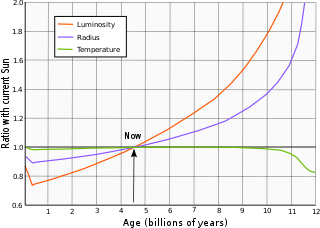Top Qs
Timeline
Chat
Perspective
Solar radius
Unit of measurement From Wikipedia, the free encyclopedia
Remove ads
A solar radius is a unit of distance, commonly understood as 695,700 km and expressed as , used mostly to express the size of an astronomical objects relative to that of the Sun, or their distance from it. This length is also called the nominal solar radius. The sun's actual radius, from which the unit of measurement is derived, is usually calculated as the radius from the sun's center out to the layer in the Sun's photosphere where the optical depth equals 2/3.[1] One solar radius can be described as follows:This is an approximation: both because such distance is difficult to measure and can be measured in various ways, and because the sun is not a perfectly spherical object itself, and thus the actual radius varies depending on the point(s) measured and modality of measurement employed.
695,700 kilometres (432,300 miles) is approximately 10 times the average radius of Jupiter; 109 times the 6378 km radius of the Earth at its equator; and or 0.0047 of an astronomical unit, the approximate average distance between Earth and the Sun. The solar radius to the sun's poles and that to the equator differ slightly due to the Sun's rotation, which induces an oblateness in the order of 10 parts per million.[2]
The solar diameter is double the solar radius.
Remove ads
Measurements

The uncrewed SOHO spacecraft was used to measure the radius of the Sun by timing transits of Mercury across the surface during 2003 and 2006. The result was a measured radius of 696,342 ± 65 kilometres (432,687 ± 40 miles).[4]
Haberreiter, Schmutz & Kosovichev (2008)[1] determined the radius corresponding to the solar photosphere to be 695,660 ± 140 kilometres (432,263 ± 87 miles). This new value is consistent with helioseismic estimates; the same study showed that previous estimates using inflection point methods had been overestimated by approximately 300 km (190 mi).
Remove ads
Nominal solar radius
In 2015, the International Astronomical Union passed Resolution B3, which defined a set of nominal conversion constants for stellar and planetary astronomy. Resolution B3 defined the nominal solar radius (symbol ) to be equal to exactly 695700 km.[5] The nominal value, which is the rounded value, within the 140 km uncertainty band given by Haberreiter, Schmutz & Kosovichev (2008), was adopted to help astronomers avoid confusion when quoting stellar radii in units of the Sun's radius, even when future observations will likely refine the Sun's actual photospheric radius (which is currently[6] only known to about an accuracy of ±100–200 km).
Remove ads
Examples
Solar radii as units of distance measurement are common especially when describing the paths of spacecraft moving close to the sun. Two such spacecraft in the 2010s include:
- Solar Orbiter (which flew as close as 45 R☉ to the sun)
- Parker Solar Probe (which flew as close as 9 R☉ to the sun)
See also
References
External links
Wikiwand - on
Seamless Wikipedia browsing. On steroids.
Remove ads



